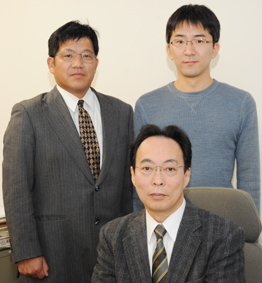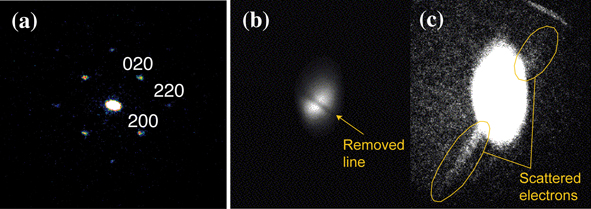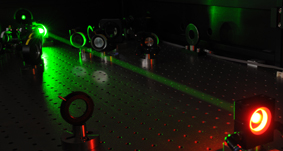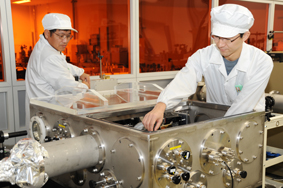Single-shot Femtosecond Electron Diffraction with Laser-accelerated Electrons: Experimental Demonstration of Electron Pulse Compression
|
Assist Prof Shigeki Tokita, Assoc Prof Masaki Hashida, Prof Shuji Sakabe, and their co-workers, Laboratory of Laser Matter Interaction Science
“Single-shot Femtosecond Electron Diffraction with Laser-accelerated Electrons: Experimental Demonstration of Electron Pulse Compression”
Published in “Physical Review Letters,” |

Prof Sakabe S(middle), Assoc Prof Hashida M(Left), Assist Prof Tokita S(right) |
||
| The Laboratory of Laser-Matter Science (directed by Prof Shuji Sakabe) is tackling the research of physics of ultra intense short pulse laser matter interactions and its applications. Radiations (electrons, x-rays, ions, THz waves, and so on) produced by intense lasers are featured by pulse, point source, high-intensity, perfect synchronization between different radiations, and so on, and have high potential for new-generation radiation sources. Since our laboratory was established, we have been studying ultra-fast electron diffraction (UED) with laser produced plasma electrons, aiming to contribute on the field of material science. | |||

Demonstration of single-shot electron diffraction by compressing an electron pulse produced and accelerated by an ultra-intense short pulse laser to 500 fs. (a) single shot electron diffraction image of gold crystal, (b) image of an electron beam which is partially removed by an intense laser pulse, (c) image of electrons scattered by an intense laser pulse. |
|||
 |
Various phenomena in matters, such as phase transitions in solid, pass-way of chemical reactions, biological functional processes, and so on are determined ultimately the motion of each atom. The establishment of the UED using a pulse electron source, which can observe directly these structural dynamics on the time scale for a single atom to move, make great contribution on material science. To realize this UED high-intensity short pulse electron source is absolutely essential. Studies to date in the world generate photo-electrons by irradiation of femtosecond laser pulses on a photocathode. However, the electron pulse generated by this way is extended much during the acceleration up to several hundred keV required for electron diffraction, by the space charge effect (Coulomb repulsive force between electron in the pulse). After all, to avoid the pulse expansion, the number of electrons in the pulse is much reduced and multiple pulses are irradiated on a sample. Therefore, observable objective phenomena are limited to reversible (the same phenomena occur by every 100-100 pulses) ones. | ||
| Our purpose is the demonstration of single pulse UED. To catch it, we are proposing and studying the usage of high-intensity short electron pulses generated and accelerated in the plasma produced by an ultra-intense ultra-short pulse laser. When an intense laser pulse is irradiated on a thin foil, electrons in the foil plasma are accelerated instantaneously up to 100 keV – 1 MeV. Therefore we do need no additional accelerator al all. The electron pulse has broad momentum spectrum, and consequently the pulse expands in time before arriving the sample. However, using this broadness, by phase inversion between the source and the sample, the pulse can be recompressed just on the sample. This method has been demonstrated for the first time in the world. Actually the diffraction patters from a gold mono crystal foil were obtained by only single laser (electron) pulse, and the electron pulse was successfully recompressed down to 500 fs. |  |
||
| We sincerely thank Professors S. Isoda and H. Kurata (Laboratory of Electron Microscopy and Crystal Chemistry of Advanced Research Center for Beam Science) for their suggestions and discussions. We are continuously formulation of the basic grounds for ultrafast electron microscopy using intense laser produced electrons by the cooperation and integration between high-intensity laser plasma research and the potential of advanced electron microscopy development. |
|||
 Institute for Chemical Research, Kyoto University
Institute for Chemical Research, Kyoto University International Joint Usage Research Center
International Joint Usage Research Center